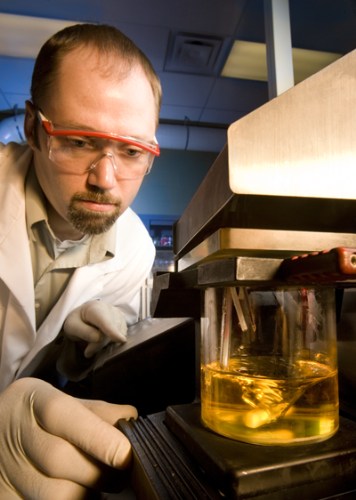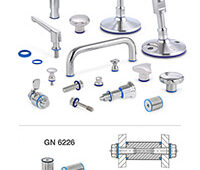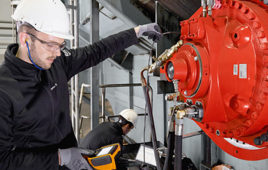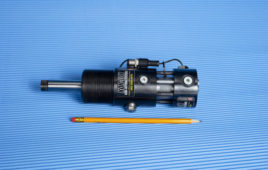Special IMTS show feature sponsored by Eaton
“Four out of five hydraulic component failures are a direct result of dirty fluids,” explains Wasan Shaffou, lab manager of Eaton’s Vickers® Fluid Analysis Service, “and that means they are almost all both predictable and preventable. Nothing lasts forever, of course, but a rigorous fluid quality maintenance program is one of the best investments a customer can make to ensure maximum practical life and optimum performance from a hydraulic system.
“Unfortunately,” she says, “an in-depth fluid analysis requires specialized equipment and highly skilled personnel, neither of which most hydraulic system users can afford to have in-house. That’s why Vickers established the Fluid Analysis Service in 1991 and why Eaton has upgraded and expanded its capabilities since acquiring Vickers in 1999.”
Located in Southfield, Mich., Eaton’s Vickers Fluid Analysis Service supports customers primarily in the United States, Canada and Mexico. The lab also serves European customers who need its specialized capabilities to identify and resolve difficult fluid contamination problems. Eaton also maintains a lab facility in Australia to serve customers in that country and its Asian neighbors.

Good Samples = Accurate Results
“The value of a fluid analysis depends entirely on the quality of the sample,” Shaffou says. “That is not a trivial detail; taking a representative sample is a very exact science.
“The system should be stable, meaning that it is at operating temperature and the fluid has been circulated sufficiently to produce a representative sample. We generally recommend obtaining the sample in the return line directly ahead of the return line filter. A well-designed system will have a permanent sampling valve installed there.
“Failing that, it’s possible to obtain good samples from the reservoir using a vacuum pump and clean tubing, or from the pressure line immediately downstream of the pump. Both of these locations require a fair amount of skill in taking the sample to avoid including non-representative contaminants, though. That is why we highly recommend the return line location,” she says.
“Many of the particles we are looking for are sub-micron,” Shaffou explains, “and that means the sample jar has to be specially prepared and ultra-clean to avoid introducing contamination. Many labs use inexpensive plastic sample jars, but we have found them to be less than satisfactory in terms of cleanliness. So, we use only glass.”
A Comprehensive Battery Of Tests
Each sample received by Eaton’s Vickers Fluid Analysis Service is assigned an individual tracking number and a data sheet that records both sample details and test results. Samples are typically processed in batches of 12 to achieve optimum operating economy from the lab’s test equipment.
“Our customer service standard is to provide 24-hour turnaround on all samples received,” Shaffou notes, “and we achieve that nearly 100-percent of the time. Some of our customers have reported waiting up to three weeks for test results from other labs, and we think that’s entirely unacceptable. You can do a lot of damage to your equipment in three weeks.”
The standard bank of tests performed on fluid samples includes:
–Particle count
–Viscosity determination
–Water content measurement
–Spectrographic analysis
–X-ray fluorescence analysis
–Photomicrography of the sample
–Total acid number determination
Viscosity, water content, particle counts and total acid determinations are reasonably self-explanatory. Taken together they give a good overview of fluid condition and overall system health.
The lab uses premium grade analytical equipment including a high quality Canon Viscometer, a Karl Fischer water machine and a Hach Ultra particle counter. Field work lab personnel use a Vickers Target Pro 2 particle counting system with a high intensity dual laser light source and photo sensor. Acid content is determined with standard chemical test procedures.
“These tests provide a good overview of what’s going on in the system,” Shaffou says, “and they are all a customer gets from many labs. We take it a couple of steps further, to provide information the customer can use to more accurately diagnose and correct the causes of the contamination we find.”
There are four basic sources of contamination in a hydraulic system:
Contaminated New Oil
Although hydraulic fluids are produced under clean conditions, by the time they have been stored, transported and transferred into a customer’s system they are nearly always contaminated with metal and rubber particles.
Built-in Contamination
This is a problem both with new equipment and equipment that has been repaired in the shop or field. Anytime a system has been opened, or a component replaced, there is a high likelihood of contamination being introduced to the oil.
Ingressed Contamination
A major source of both particulate and water contamination is from the environment. Ingressed contamination typically finds its way into a system through reservoir vents, open access plates and cylinder seals.
Generated Contamination
The most destructive contaminants in most system are metal particles stripped off the surface of system components by friction. If not found and corrected immediately, these particles quickly create more particles in a cascade effect that dramatically shortens the life of all system components.
“The basic tests give the customer a good handle on the first three sources of contamination,” Shaffou says. “Things like water content or plain ‘dirt’ are reasonably easy to track down at the source and eliminate once you know they are present. Factors like viscosity breakdown also have known sources, primarily overheating and oxidation, that are relatively easy to diagnose and remedy.”
Beyond The Basics
“What the more advanced Spectrographic and X-ray florescence tests provide is insight into the more difficult to diagnose contamination sources, and the truly strange ones as well. For example, knowing the exact chemical make-up of contaminant particles can help the customer determine exactly where in the system they are being generated.
“Consider the possibilities in a pump. It may have cast iron end caps, an aluminum body, an alloy steel shaft, gears, bearings, other components of various metals and seals made of a whole range of polymers.
“It’s not enough just to know the system is generating metal particles,” she says. “What the customer needs to know is exactly what kind of particles in exactly what proportions. That information can be used diagnostically to eliminate the source of the problem.
“If you know that the system in this example is contaminated with alloy steel, you can be pretty sure it isn’t coming from the end caps or pump body. That level of detail makes tracking down the source a lot easier.
“And then you always have to be on the lookout for the truly strange things that can get into a hydraulic system. Like the egg salad sandwich that was the proximate cause of a pump failure in one case. We see those every once in a while, too.”
Actionable Information
All of the information the Fluid Analysis Service generates is returned to the customer in the form of an in-depth, standardized report. The report contains both quantitative analyses, and graphical representations of the contaminants found to assist the customer in utilizing the information to diagnose and eliminate the sources of contamination found.
When done regularly over the life of a system, the series of reports identify developing trends as well as singular anomalies, and give the customer valuable insights to support both reactive and proactive maintenance strategies. Eaton’s unique position as a fluid analysis laboratory, a hydraulic fluid supplier and a manufacturer of hydraulic components adds value to the report data by augmenting it with access to “hands-on” technical advice and field support.
“We try to make the report as comprehensive as possible,” Shaffou says. “To that end we include not only quantitative data on contaminants like particle size distribution and composition, but also suggested sources for the particular contaminants found. The goal is to provide as much actionable information as possible, as quickly as possible.
“After all,” she says, “that’s what the customer needs, and that’s what they come to us for again and again. We look at ourselves as part of the team that is working to make sure that the 80 percent of hydraulic failures attributable to dirty fluid happen to someone else’s system, not our customer’s.”
::Design World::
Filed Under: Hydraulic equipment + components, FLUID POWER





Tell Us What You Think!